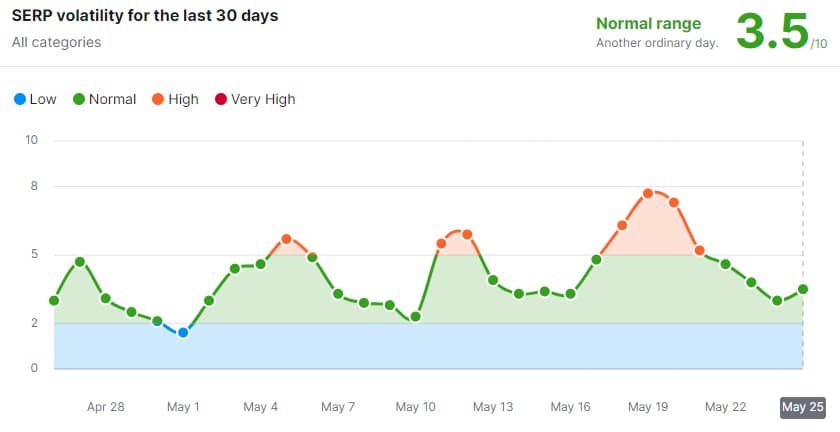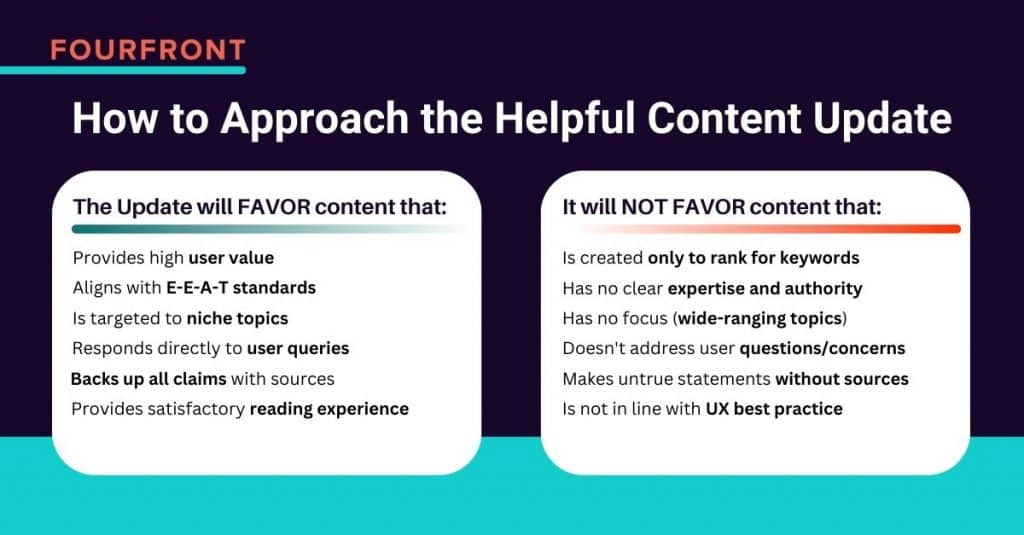When it comes to SEO, it’s important to understand one simple thing: What does Google want?
Google’s overarching goal for its search function has always been to provide the most relevant content for every query, so that users have a good experience and continue to choose Google for their future searches.
To that end, the tech giant continually updates its algorithm to enhance the quality and relevancy of search results. Examples of these broad updates include Panda (2011), Penguin (2012), and Hummingbird (2013), each with a unique focus on improving specific aspects of the search experience.
The latest in this dynasty of updates is the Helpful Content Update. The goal of this sweeping update is to prioritize high-quality, user-centric content in Google’s search results and is a key component of Google’s future plans for Search.
What is the Helpful Content Update?
Google’s Helpful Content Update is an important part of the search engine’s ongoing efforts to ensure users get the most relevant and valuable search results. Its purpose is to prioritize content that provides a satisfying experience for users.
Since its initial release in mid-2022, Google’s Helpful Content Update has sparked a significant reaction from the SEO community, highlighting the potential implications for non-content ranking factors. Non-content ranking factors are things like page experience, internal and external links, etc. – the features of your site other than the written content that the search engine takes into consideration when ranking your page.
Recently, Google announced plans to make further changes to the Helpful Content System, indicating an increased focus on user experience in their ranking algorithms.
What Has Its Impact Been So Far?
The Helpful Content Update has had a notable impact on search results. In fact, data visualized by ranking tools like Semrush’s Volatility Sensor shows significant changes in SERP volatility since the update.
The changes have been felt across industries, with some experiencing more turbulence than others. The update targeted low-value, spammy content, causing sites with automated or scraped content to experience negative impacts, while those providing genuine value largely remained untouched, or even saw some considerable improvement in their ranking and visibility.
Some industries, such as healthcare, have had to adjust significantly in the aftermath of the Helpful Content Update. With an increasing number of consumers seeking health information online, healthcare providers must now generate original, high-quality, informational content to answer patients’ questions effectively. Other industries, like lifestyle publications and review websites, which are heavily reliant on content for lead generation also felt the update’s impact.

The good news (or bad news, depending on who you talk to) is that this whole “Helpful Content” thing isn’t going to be a “one and done” system. It was initially introduced in August 2022, updated in December 2022, and now Google has announced additional updates set to take effect sometime in mid-2023. This update is expected to help Google better understand and interpret content created from a personal, expert point of view.
So, What Does “Helpful Content” Actually Mean?
I get it, “helpful” feels kind of subjective. How can a whole huge update to the world of search be based on an idea that is so entirely dependent on a given searcher’s needs and goals? Luckily, Google has a truly unfathomable amount of data on the kinds of content that actually answer people’s questions.
In the context of SEO, “helpful content” refers to content that meets the needs of users first and foremost, rather than prioritizing search engine algorithms. The update underscored the importance of avoiding misleading or repetitive content, creating user-friendly interfaces, and focusing on relevant topics within an organization’s area of expertise.
Meeting the needs of users also means some potentially significant changes to the ways in which information is conveyed. It used to be that the default for search-optimized content was words on a page. Sometimes lots of words on a page. But now, thanks in part to Google’s 2021 MUM update, multimedia content is fair game for search, meaning that content creators have more freedom (and responsibility) to deliver information in the format that best serves the searcher. Even if that’s a video, a podcast episode, or a short text post.
How Does Google Evaluate Content?
Google evaluates content based on several factors which have evolved over time as Google’s search algorithms become more sophisticated. While the exact workings of Google’s algorithm are proprietary and not fully disclosed, Google has provided some guidance on what it values in high-quality content. Here are a few key factors:
- Relevance
- Quality
- Experience, Expertise, Authoritativeness, and Trustworthiness (E-E-A-T)
- User Experience
- Engagement
While what Google considers to be “helpful” content definitely falls within those standard measures, in their guide to creating helpful content, Google also recommends an emphasis on searcher-first content that considers who the content was created by, how the content was created, and why the content was created in the first place.
In short, content that will do well under this new system is high-quality, well-researched, transparent, easy-to-use content that adds something new or important to the larger discourse on the topic.
Content and Quality
Focus on originality and quality. Here are three key takeaways from Google’s guidelines:
1. Be Original and Insightful
Google loves content that’s fresh, original, and full of insight. So, aim to bring something new to the table, not just rehashing what’s already out there. If you’re drawing from other sources, don’t just copy or rewrite what they’ve said. Add your own spin, your unique insights, and bring something extra to the conversation.
Since any post about content writing in 2023 would be remiss to not mention AI and ChatGPT, let’s talk AI real quick. The ever-expanding universe of AI tools can be incredibly powerful for streamlining and expediting your content writing process – from keyword research, to outlines, to even drafting content for you – but speedy AI content is no replacement for valuable, well-researched, authoritative content written by real, human experts. Again, it’s quality over quantity, my friends!
If you want to learn more about how to add ChatGPT to your digital marketing toolbelt, check out my recent blog post:

ChatGPT for Marketing: Expert Use Cases and An Interview with ChatGPT
Staying up-to-date on emerging trends is an important part of being a smart, effective marketer. One trend we’ve been watching closely is the use of
2. Give the Full Picture
Your content should be thorough and valuable. It should cover your topic completely and offer more value than other pages people might find in search results. And skip the click-bait. Make sure your titles are clear, descriptive, and genuinely reflect what’s in your content.
3.Quality Counts
Keep an eye on the quality of your content. It should look professional, be well-written, and free from typos or other errors. Avoid churning out tons of content or outsourcing it all over the place. Your aim is to create content that’s so good, people want to bookmark it, share it, or even see it referenced in a book or magazine. Quality over quantity, always.
Expertise
Trustworthiness: Your content should feel reliable, with clear sources and author or site background info.
Authority: If people look into your site, they should see it as a trusted expert on the topic.
Expert Perspective: Content should be written by knowledgeable folks who really understand the topic.
Accuracy: Be sure to avoid any factual errors; always fact-check your content.
Presentation and Production
I’m a big fan of things that are both beautiful and useful and, evidently, so is Google. When it comes to a webpage, looks and usefulness go hand in hand.
Google likes pages that not only look sharp and trustworthy but are also typo-free, well-organized, easy to read, and easy to navigate. And try to have a great user experience across the board (and across your site!)
People-First Approach
Crafting content should be about serving the actual humans who land on your page, not gaming the search engines. But how do you know if you’re doing it right? Consider this:
- Are you making useful content for your audience?
- Does your content reflect real expertise and deep knowledge?
- Does your site have a clear focus?
- Does your content leave readers feeling informed and satisfied?

Recovering from Previous Updates
Just as Google’s Broad Core Updates can throw a curveball at your website’s performance, the Helpful Content Update can have a similar effect. If you’ve noticed a dip in your metrics, it’s likely that the content on your site hasn’t been viewed favorably by this update.
Here’s the tricky part though – there’s no straightforward fix to remedy a poor helpful content signal assigned by Google. But don’t let that discourage you. There are ways to bounce back and improve your site’s standing, starting with a return to the basics.
First off, take a step back and revisit Google’s guidelines on crafting helpful content. Pay close attention to the questions they pose – and the people-first questions I already mentioned. They’re designed to help you diagnose any issues with your current content and guide you on how to make it more valuable for your audience. So, make answering these questions your starting point.
Just remember, there’s no magic wand to wave here. Your website’s performance won’t rebound overnight. The timeline for recovery tends to vary, often due to external factors like the competitive landscape and search trends. Patience and persistence are key.
Remember, it’s all about creating content that’s truly useful and meaningful to your audience. Keep this at the forefront of your strategy, and you’ll be on the right path to recovery and growth.
Navigating a Content-First World
Feeling anxious about the Helpful Content Update’s impact on your site? You’re not alone. But worry not, FourFront is here to help.
As an esteemed SEO agency, we have a knack for creating quality content that aligns with Google’s guidelines and connects with your audience. From crafting a content strategy to writing compelling copy, we’ve got you covered.
Let’s team up to navigate this content-first world together. Trust us with your content needs, so you can focus on what you do best – running your business.








